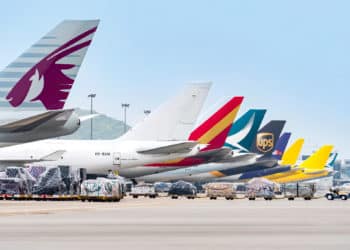No products in the cart.
Surging trade delivers broad gains to March 2017 cargo traffic
 Note — 14 April 2017: This post has been updated to reflect the latest traffic results.
Note — 14 April 2017: This post has been updated to reflect the latest traffic results.
Many of the major carriers in Europe and North America, as well as several from Asia, have now reported their March 2017 traffic figures,and the results are almost universally good.
Despite the politically tumultuous 2016 which saw the UK vote to leave the European Union, and countless threats by the newly-elected US President to incite a protectionist trade war with some of the country’s largest trading partners, trade volumes have continued to soar.
Amsterdam’s Schiphol Airport reported its March handle up 9.5% to 154,000 tonnes. For the first three months of the year, Schiphol’s handle was up 8.0% to 420,000 tonnes.
Frankfurt Airport (FRA) reported its cargo handle up 10.5% y-o-y to 203,000 tonnes in March, which was no surprise considering the largest cargo carrier based at the airport, Lufthansa saw its March cargo traffic up 13.3% For the first three months of 2017, FRA’s handle was up 6.3% to 528,000 tonnes.
London’s Heathrow airport handled record volumes in March, with volumes up 11.2% to 148,000 tonnes. On one hand, a cheaper British Pound was thought to have driven exports higher. Additionally, a potential one-off boon could be this year’s poor harvest in Southern Europe, which is driving perishables imports into Europe.
Europe’s big three-carriers also fared well in March. After being mired in declines and slashing freighter capacity for years, Air France-KLM Cargo reported traffic up 5.6% y-o-y to 751 million RTKs, and is even up 0.5% compared to the same period in 2016. Lufthansa’s recovery plan also appears to be paying off, reporting March cargo traffic up 13.3% y-o-y, to 980 million RTKs. IAG was also up 6.6% y-o-y to 501 million RTKs.
Shifting to North America, Delta Air Lines now joins its compatriots United and American Airlines in reporting decent cargo figures. Delta had been lagging behind its peers, and for the first month in quite some time, reported March cargo traffic up 5.7% y-o-y to 251 million RTKs. For the year through March, Delta’s cargo traffic was still down 1.4%.
When IATA and WorldACD report their worldwide summaries in a couple of weeks, we would not be surprised to see year-over-year increases in demand for air freight in double digits.
Now for the details…
Asia Pacific
Beijing-based Air China reported its March cargo traffic up 3.3% y-o-y to 606 million RTKs. International traffic was up 3.6%% for the month to 455 million RTKs, while domestic traffic rose a similar 2.6% to 142 million RTKs. The much smaller regional traffic fell slightly (0.9%) to 9.4 million RTKs. For the combined January-through-March period, Air China’s cargo traffic was up 4.5% to 1.63 billion RTKs.
Guangzhou-based China Southern Airlines reported March cargo traffic up 19.2% y-o-y to 618.1 million RTKs. International traffic represented the fastest growing segment, up 26.9% to 474 million RTKs. Domestic traffic was nearly flat (down 0.9%) at 141.8 million RTKs. The much smaller regional traffic was up 19.9% to 2.1 million RTKs. For the first three months of the year, China Southern’s cargo traffic was up 14.25% to 1.54 billion RTKs.
Shanghai Pudong International Airport Cargo Terminal Co Ltd (Pactl, the biggest handler at Shanghai’s Pudong Airport) reported a 11.4% y-o-y increase in its March cargo handle to 158,000 tonnes. International volume for the month was up 12.1% to 133,000 tonnes, while the much smaller domestic volume was nearly flat (up 0.1%) to 9,000 tonnes (most of Shanghai’s domestic cargo moves through nearby Hongqiao Airport). For the first three months of 2017, Pactl’s handle was up 11.9% to 368,000 tonnes.
Taiwan-based China Airlines reported March cargo traffic up 9.2% y-o-y to 452 million RTKs, the eighth month of increased traffic after a long period of declining demand. Year-to-date, CAL’s cargo traffic was up 8.6% to 1.2 billion RTKs.
Taiwan-based EVA Air reported March cargo traffic up 6.1% y-o-y to 295 million RTKs, its tenth consecutive positive result after a year-and-a-half of declines. For the year to date, EVA’s cargo traffic was up 6.9% to 796 million RTKs.
South Korea’s Incheon Airport reported its March cargo handle up 11.7%, to 260,000 tonnes. Year-to-date, traffic was up 12.2% to 686,000 tonnes.
Europe & Middle East
The demand recovery at Lufthansa that started in July and August last year, continued through the first three months of 2017, with the carrier reporting March cargo traffic up 13.3% y-o-y to 980 million RTKs. The growth was led by a 15% increase in traffic on the Asia-Pacific lane to 449 million RTKs. The carrier’s other major trade lane, connecting Europe to the Americas, also performed well, with traffic up 13.8% to 424 million RTKs. Traffic to/from the Middle East and Africa rose 6.6% to 72 million RTKs, and intra-Europe traffic was slightly positive (up 1.4%) to 34 million RTKs. For the first three months of this year Lufthansa’s cargo traffic was up 8.3% to 2.50 billion RTKs.
Air France-KLM reported March cargo traffic up 5.6% y-o-y to 751 million RTKs, marking a significant turnaround after months of declines. Of the two carriers in the group, Air France reported its March traffic up 10% to 330 million RTKs, and even KLM which has been lagging due to significant capacity cuts to its freighter fleet, saw growth of 2.0%, to 421 million RTKs. For the year to date through March, AF-KLM’s cargo traffic pulled into positive territory, up 0.5% to 2.04 billion RTKs.
International Airlines Group reported March cargo traffic up 6.6% y-o-y to 501 million RTKs. Subsidiary carrier British Airways reported March cargo traffic up 6.5% to 392 million RTKs, while Iberia’s cargo traffic rose 3.3% to 94 million RTKs. The much smaller cargo traffic at Aer Lingus jumped 36.4% to 15 million RTKs. For the first three months of 2017, IAG’s cargo traffic was up 3.6% to 1.37 billion RTKs.
London’s Heathrow Airport (LHR) reported its March handle up 11.2% to 148,000 tonnes, a record handle for the airport. Year-to-date, LHR’s handle was up 6.8%, to 399,000 tonnes.
Americas
Cargo traffic continued to fall fast at Chile-headquartered LATAM Airlines Group, which reported March traffic down 10.6% y-o-y to 270 million RTKs. For the first three months of 2017, LATAM’s cargo traffic was down 7.3% to 810 million RTKs. As part of an ongoing restructuring process, LATAM Cargo has appointed Andrés Bianchi as its new CEO. Under Bianchi’s leadership LATAM will focus on increasing competitiveness through productivity enhancements and improvements to its product portfolio. It’s about time too, LATAM Cargo has reported y-o-y monthly declines for all but one month since February 2014.
United Airlines reported March cargo traffic up 23.8% y-o-y to 409 million RTKs, its twelfth consecutive month of strong gains. Year-to-date, United’s cargo traffic was up 20.3% to 1.09 billion RTKs.
American Airlines Group reported March cargo traffic up 16.6% y-o-y to 346 million RTKs. For the first three months of this year, American’s cargo traffic was up 13.9% to 904 million RTKs.
After months of consecutive declines, a turnaround plan at Delta Air Lines may finally be paying off. The Atlanta-based reported March cargo traffic up 5.7% y-o-y to 251 million RTKs. For the year through March, Delta’s cargo traffic was still negative, down 1.4%
Is the air cargo industry ready to discard “the new-normal” growth rate (which tracks GDP growth) in favor of something much higher? Those interested in learning more about where air freight is headed for the remainder of the year are invited to join us at Cargo Facts Asia in Shanghai, 25-26 April panelists from leading carriers and logistics companies will explore the topic at length. To register, or for more information, visit www.cargofactsasia.com.





